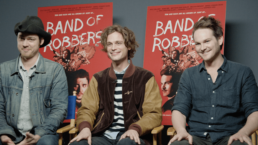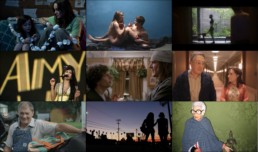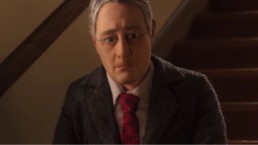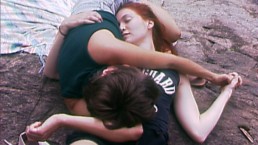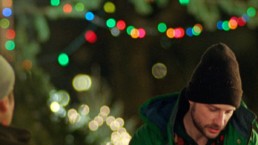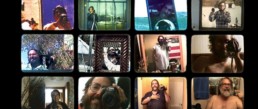Matthew Gray Gubler, Adam & Aaron Nee Talk 'Band of Robbers'
Days before the theatrical release of the comedy/crime film Band of Robbers, Morgan sat down with Matthew Gray Gubler, Adam Nee, and Aaron Nee to discuss some very serious questions... and by that we mean not serious at all and instead we just practically laugh the whole time. We talk New Year's resolutions, heroes, and favorite scenes from the film!
Band of Robbers- the modern-day Huck Finn and Tom Sawyer treasure hunt re-imagining- opens today at the Laemmle Playhouse 7 and on VoD.
Morgan's Top 10 Films of 2015
What we consider to be the best of this year represents a combination of the movies that had the greatest emotional impact on us, matched with movies that felt innovative or groundbreaking. Here are the films Morgan considers to be this year’s best:

10. Finders Keepers
In 2007, Shannon Whisnant got a lot more than he bargained for when he bid on a used grill from a repossessed storage unit at a local flea market–he got a severed human foot, belonging to one John Wood. As bizarre as it sounds, this is a true story, and it all happens within the first act of the documentary Finders Keepers, truly one of the strangest and funniest films of the year. Directors Bryan Carberry and Clay Tweel have really found a needle in a haystack with the subject of this film. While the whole thing's flat-out funny, they don’t shy away from hitting poignant, emotional notes that ground the film and give it substance.

9. It Follows
Now, I'm not usually one to walk away from a horror film talking about how ingenious it was, but leave it to David Robert Mitchell's breakout festival hit It Follows to not only bombard my mind with realistically terrifying thoughts that night but for many nights after. Rising star Maika Monroe plays 19-year-old Jay, who, after a seemingly innocent sexual encounter, suddenly finds herself plagued by nightmarish visions. She can't shake the sensation that someone, or something, is following her. A fantastic film for the modern day horror-fan that gets just about everything right.

8. The End of the Tour
The End of the Tour is based on real-life journalist David Lipsky’s critically acclaimed memoir, "Although Of Course You End Up Becoming Yourself: A Road Trip with David Foster Wallace," which chronicles the highs and lows of his 1996 five day journey with the acclaimed post-modern author. Meditative and thought provoking, The End of the Tour captures the complexity of one man’s life through a delicate lens. A neatly wrapped package with stand-out performances, this is an example of what finely-crafted filmmaking looks–and, more importantly–feels, like.

7. Tangerine
This micro-indie surges energy and pulses with electricity at every turn and around every corner of its L.A. backdrop. It also happens to be shot entirely on the iPhone 5s. Like its off-beat shooting style, the flick of the summer Tangerine, is all attitude, all brash, and all defiant in its film-making. It takes just one moment to learn this after meeting our main characters in the film’s opening scene: two Trans prostitutes, Alexandra (Mya Taylor) and Sin-Dee (Kitana Kiki Rodriguez), a colorful cast of characters in this seedy, yellow and green colored L.A. circus world. (–Ryan Rojas)

6. Amy
It’s been about 4 years since her untimely death at the age of 27, but with each passing year, Amy Winehouse's musical legacy only continues to grow stronger. Director Asif Kapadia's Amy is a heartbreaking documentary, that shows, with an incredible amount of never before seen footage, the brilliant artist she was, her troubled personal relationships, and addictions that led her down a dark path of self-destruction that she was unable to escape from. However, for as heavy-handed as this film comes across, we are left remembering a brilliant artist.

5. Iris
As a 93-year-old fashion icon known world-wide, Iris Apfel exudes a naturalness that makes you feel as if you know her. Her body is fragile, her clothes are flamboyant, and her soul is, above all else, happy. Director Albert Maysles, whose previous films include Grey Gardens and Gimme Shelter, takes audiences into Apfel’s life behind the scenes in the documentary Iris. From her private apartment in New York that she shares with her 100-year-old husband Carl, to her storage warehouse that doubles as a closet, we embark on an 80-minute journey that finds inspiration, as well as words of wisdom from Iris herself, at every turn.

4. The Tribe
A standout at last year’s Cannes Film Festival is the Ukrainian crime drama The Tribe, about a deaf teenager struggling to fit in at his new boarding school and told entirely through non-verbal acting and sign language with no voice overs or subtitles. If that doesn’t sound interesting enough, note the fact that the cast is made up of entirely non-professional actors. It is a modern day silent movie with a vibrancy that will leave a lasting impression on those who are willing to experience this unique art film. The Tribe was made for an audience waiting for an authentically beautiful and powerful piece of cinematic art.

3. Ex Machina
Ex Machina is one of the most aesthetically beautiful and stylish films to come out this year. Writer/Director Alex Garland's "Sci-Fi meets Mystery" film tells the story of a young programmer, Caleb (Domhnall Gleeson), who is selected to participate in the opportunity to test an artificially intelligent robot, Ava, (Alicia Vikander) created by the tech-wiz recluse and quirk-capitalist Nathan (Oscar Isaac). Caleb is tasked to test which qualities make Ava exactly human enough, through a series of interviews that lead to more and more uncertainties. Suspenseful and intelligent, Ex Machina also stars some of the year's hottest actors–Vikander also stars in this year's The Danish Girl and both Isaac (and Gleeson) can be seen in one of the year's biggest films, Star Wars: The Force Awakens.

2. Room
Brie Larson delivers one of the strongest performances of her career as Ma, a victim of a kidnapping who has been forced to create a home out of the petty 10″x 10″ woodshed where she and her son Jack (Jacob Tremblay) are held captive. One night, Ma hatches a risky plan that could either result in living happily ever after in the real world, or risk never seeing each other again. Touting Oscar buzz (and rightfully so), Room is one of those special films that gets everything right: from phenomenal performances, to ingenious storytelling and visceral camerawork, this isn’t just a movie–it truly is a full body experience. And although it can be uncomfortable at times, it pushes the audience to tap into emotions in a way that has rarely been done before.

1. Anomalisa
He is the mind behind some of cinema's most creative and original films, such as 1999’s Being John Malkovich, 2002’s Adaptation, and 2004’s Eternal Sunshine of the Spotless Mind. Now, screenwriter-turned-director Charlie Kaufman is back with his second directed feature film, Anomalisa. In similar Kaufman fashion, the protagonist is a middle-aged cynic crippled by the mundanity of modern life, only to come to life when a stranger opens his eyes and ears to the beauty of human connection, if only for a moment. Anomalisa is a transfixing, thoughtful, and touching film that goes deep into the viewer's psyche and stirs up emotions of introspective thought. Critics are highly praising the film's ability to transcend reality, as Anomalisa has been nominated for an Oscar for Best Animated Feature Film, leaving no doubt that Kaufman's latest masterpiece stands out as one of the year’s best.
Review: 'Anomalisa'
He is the mind behind some of cinema's most creative and original films, such as 1999’s Being John Malkovich, 2002’s Adaptation, and 2004’s Eternal Sunshine of the Spotless Mind – now, screenwriter-turned-director Charlie Kaufman is back with his second feature film, Anomalisa. In similar Kaufman fashion, the protagonist is a middle-aged cynic crippled by the mundanity of modern life, only to come to life when a stranger opens his eyes and ears to the beauty of human connection, if only for a moment.
Michael Stone (David Thewlis) is a customer service businessman, unhappy while constantly traveling to speaking engagements across the country. As the author of a highly successful book detailing the way to victory in the field, Stone finds himself a semi-celebrity, ever-reluctantly. Despite his outward successes, the married father of one longs for more – something, anything, to snap him out of his melancholy existence. Everyone he meets literally looks and sounds the same, a clever ruse in which the third billed Tom Noonan voices every other character (credited as "Everyone Else"). It’s on a trip to Cincinnati when everything changes, when he meets the quirky Lisa (Jennifer Jason Leigh), different from anyone he has ever met, with a liveliness that awakens a passion inside him that he had long thought was gone. Together, Michael and Lisa embark on a personal journey of love and heartbreak that makes for one unforgettable experience.
Despite the inherently childlike quality of a stop-motion animated film, Anomalisa is definitely not for children. The animated format includes adult subject matter, including scenes of sexual content, which only serve to highlight the film’s mature themes.
'Anomalisa' is a transfixing, thoughtful, and touching film that goes deep into the viewer's psyche and stirs up emotions of introspective thought.
The stop-motion production is a marvel, taking a full day's work for animators to create just two seconds worth of screen time. Because of the tedious nature of the job and close attention to detail, no second in Anomalisa is wasted. The quirky mannerisms exhibited by everyday people that otherwise go unnoticed in daily life are so carefully captured here, playing as some of the film’s most inspired laughs. Composer Carter Burwell creates a minimal but beautiful soundtrack to emphasize Michael's desires, resonating with and affecting all.
Kaufman originally penned this longing-for-love story for the stage (released under the pseudonym Francis Fregoli) and cast David Thewlis, Jennifer Jason Leigh, and Tom Noonan to be his principal, and only, actors. With growing interest of turning this "sound play" into a film, Kaufman hesitated, afraid that the movie adaptation would lose authenticity. Those who backed the film's production on Kickstarter had other thoughts, however, as the film raised over $400,000 of its $200,000 goal and proved that the interest was there and ready. With support from Starburns Industries and co-director Duke Johnson, Kaufman recruited his original cast of three to create the film.
Anomalisa is a transfixing, thoughtful, and touching film that goes deep into the viewer's psyche and stirs up emotions of introspective thought. Critics are highly praising the film's ability to transcend reality. Anomalisa has been nominated for an Oscar for Best Animated Feature Film, and there is no doubt that Kaufman's latest masterpiece stands out as one of the year’s best.
Anomalisa opens with a limited release at the Landmark on December 30. Rated R for strong sexual content, graphic nudity and language.
https://www.youtube.com/watch?v=WQkHA3fHk_0
Review: 'Stinking Heaven'
Factory 25, the same company that brought us Christmas, Again (and rising star Hannah Gross), is back with another micro-budget narrative steeped in realism and youth culture with the film Stinking Heaven. In it, a group of ex-addicts deal with the challenges of sober living and face the harsh realities of their choices in this earnest attempt at a slice-of-life drama from director Nathan Silver.
Right off the bat, Silver draws attention to the film's old-school style. Taking place in New Jersey in 1990, he pays homage to the technology of the times by shooting Stinking Heaven on an Ikegami betacam—a news camera commonly used in the early 70s. The quality, while intentionally grainy and double exposed in some scenes is intriguing- most of the time. And while the look is meant to mimic the docu-style of the 90s, the slow push-in close-ups of characters are more reminiscent of old soap operas; it's an effect that tries a bit too hard to be edgy and ends up feeling rather cheap at times.
'Stinking Heaven' will appeal to those who found the grittiness of 'Heaven Knows What' and 'Tangerine' a pleasurable viewing experience.
Stinking Heaven is centered around a sober-living home, where destitute young adults find themselves living among other like-minded individuals who find comfort in conformity and regulation. Drawing similarities from religious cults or communes, the group's requirements include mandatory participation in all house activities. Since they do not work they make a living selling a fermented health drink out of their shared van, real "hippie shit" as one customer points out. While the film has no main protagonist, Hannah Gross is one recognizable face whose character, Ann, finds herself seeking solace in the home which causes a disruption in her ex-girlfriend's attempt to regain control over her life.
With a nomination for the Audience award in the American Independents category at this year's AFI FEST, Stinking Heaven will appeal to those who found the grittiness of Heaven Knows What and Tangerine a pleasurable viewing experience. Despite not having as strong of a plot or linear storyline as the previously mentioned films, this type of filmmaking should be celebrated for its uniqueness and contribution to the indie catalog.
Stinking Heaven opens in Los Angeles at Arena Cinema this Friday and is available to stream on Fandor. Unrated.
https://www.youtube.com/watch?v=ylolqPHxxNA
Review: 'Christmas, Again'
Rising indie star Kentucker Audley finds himself working the night shift of a 24-hour Christmas tree lot in New York City in the drama Christmas, Again. Director Charles Poekel's romance/art film hybrid is a welcome addition to the holiday movie genre, going against the Douglas Fir grain of your typical "Merry and Bright" expectations. Christmas, Again is methodical, nuanced, and a breath of fresh air in which nothing really happens, but is still a pleasure to watch.
Bundled in plaid and a 5 o'clock shadow, Audley plays the auspiciously named character, Noel, a newly single, twenty-something night shift worker whose daily routine consists of sleeping in a cramped trailer during the day and working at a makeshift tree lot at night. He is a man of few words but of conviction. Though a man of few words, he is a man of conviction with incredible patience despite having to make small talk with customers who often lack both common courtesy and people skills. Noel's years as a tree salesman seem to have created a sense of apathy towards these customers so he doesn't take offense to their attitudes.
An official Sundance Selection charmer, Christmas, Again is a carefully unfolding look at the holiday through the eyes of our reserved protagonist Noel.
It isn't until one night when Noel spots an out-of-sorts and visibly drunk woman (Hannah Gross) sitting much too close to a homeless man, that his mundane routine changes. After retrieving her cell phone back from the homeless man, Noel carries her back to his trailer and cares for her, even gently cutting the gum out of her long brunette hair. After leaving the next morning without saying a word, she returns later that day and sheepishly introduces herself as Lydia, realizing in her drunken stupor that she had also lost her wallet and a shoe. This brief encounter is all it takes to bring Noel back to life, snapping him out of his monotonous rut. Lydia is authentic, genuine, and obviously beautiful. For a guy whose satisfaction came from helping other people get into the holiday spirit, Lydia may finally be his gift.
Christmas, Again has the unique ability to heighten the viewer's senses; from the smell of the chlorine from the gymnasium pool to the pine needles falling from the trees, we are immediately transported to a cold winter's night. Director Charles Poekel's decision to shoot on 16mm film is also bold and smart as it gives the film a worn in, warm feeling with a timeless quality.
An official Sundance Selection charmer, Christmas, Again is a carefully unfolding look at the holiday through the eyes of our reserved protagonist Noel. Kentucker's performance is another fantastic one, but personally, I'd like to see him in a role where he is the one to stir things up instead of just going along for the ride (See: Funny Bunny, The Sacrament) and I look forward to seeing a film that pushes his acting limits a bit more. In the midst of the inevitable holiday overdrive, Christmas, Again is a welcome slow burn of enjoyment and reflection on the nuances of the season.
Christmas, Again opens this Friday at the Laemmle NoHo 7 and on iTunes and select digital/ cable platforms.
https://www.youtube.com/watch?v=DZGHw3uJJAk
Review: 'The Letters'
Mother Teresa's 50-year epic journey from a cloistered nun to a renowned and iconic humanitarian is brought to the big screen in the drama The Letters. Director William Riead assembles a powerful cast to bring the letters Mother Teresa wrote to her spiritual advisor, Father Celest van Exem, to life. Her story is truly a fascinating one but, unfortunately, the film can't quite match the totality of the story, lacking the passion and vigor to keep our interest for the duration of its 114-minute runtime.
In the beginning, Sister Teresa was just another one of the many cloistered nuns living in the impoverished city of Calcutta, India's capital. One unsuspecting afternoon, she believes to have heard the voice of God call her to leave her current teaching position and serve the poor in the slums. This "call within a call", she writes in one letter, was the beginning of her true life's passion, becoming a voice for those in dire need of help and love. In 1950, she was elected to "Mother" after her self-started congregation- The Missionaries of Charity- was recognized by the pope and the church.
'The Letters' had the potential to be such a powerful, emotional, and laudable film with the word "Oscar" written all over it.
In a similar narrative style to The Notebook, Father Celest van Exem acts as a narrator using Mother Teresa's letters as the script. The story jumps from the past to present day, as the priests push her canonization into sainthood after her death in 1997. As far as performances go, Juliet Stevenson transforms into Mother Teresa, adopting her frail mannerisms and gentle soul. She exudes confidence and heroism as the driving force behind the story.
The biggest critique comes from the film's pacing. The beginning was so rushed, that in a state of confusion I actually had to rewind and rewatch the first few minutes to get a better understanding of the story. The second act- where Mother Teresa overcomes a hasty unwelcoming from the Hindus who distrusted her presence in their community because of her Catholic beliefs, to finally gaining their acceptance- takes it's time to build and develop. This is the crux of the story, so the attention paid here is expected, but then the third act rushes by too quickly. In the last few minutes of the film, she has accepted a Nobel Peace Prize, becomes a globally recognized and worshiped name, and has enlightened the world on her "call within a call".
The Letters had the potential to be such a powerful, emotional, and laudable film with the word "Oscar" written all over it. Instead, what we have here is a fair, melodramatic biopic that underwhelms when compared to what truly great work Mother Teresa accomplished.
The Letters is now playing in over 1,000 theaters nationwide including the Laemmle Playhouse 7, ArcLight, AMC, and Pacific Theaters.
https://www.youtube.com/watch?v=cyAujrEur-U&feature=youtu.be
First Look at Sam vs Jeremiah in 'Sam Klemke's Time Machine'
Review: 'Kingdom of Shadows'
With all of the negativity and tragedy in the news lately, the last thing one wants to think about is another face of evil, but we cannot turn a blind eye to the ugly truths that are life's reality. This time, evilness comes in the form of rampant drug cartels in Mexico, whose utter disregard for human life is traumatizing it's own citizens. Kingdom of Shadows is a documentary that profiles three individuals trying to live among the corruption from Mexico's devastated city of Monterrey. Innocent people are dying and fingers are pointing blame in all directions, but one thing is made crystal clear- drugs in Mexico present a real problem and they come with deadly consequences.
The three people we follow through the film have all been personally affected by this ongoing war against drugs. Sister Consuelo Morales defiantly takes on the Mexican government in her quest for answers to support of the families whose loved ones have gone "missing". She acts as voice for the victims who believe the police and state officials know more than they are letting on. The second man is Don Henry Ford Jr., a rancher from Texas who was once a prominent marijuana smuggler. He crossed the Texas/Mexico border numerous times until he was eventually caught and jailed. He recounts his days of working for top Mexican drug lords as well as his regrets on the direction his life has gone.
However, director Bernardo Ruiz's documentary, much like this issue, cannot be ignored.
The third person, and by far the most interesting, is Oscar Hagelsieb. Once an undercover agent, Oscar, now a senior Homeland Security Officer, talks about his close encounters with smugglers and the daily fear for his safety and the safety of his family. Recovered video footage of his undercover work is so riveting, it is nearly impossible to look away.
Kingdom of Shadows is heavy handed, especially with its unfortunate release at a time when war and terror is an extremely sensitive subject. However, director Bernardo Ruiz's documentary, much like this issue, cannot be ignored. This is a country where mass graves are multiplying by the day and hundreds of innocent people are "disappearing". Kingdom of Shadows may not have the answers to solve the problem it presents onscreen, but educating viewers is the first step. There have been films before Shadows, like Cartel Land and Narco Cultura, and there will be more to come. Unfortunately, the subject matter in this film is becoming much too similar.
Kingdom of Shadows opens at the Downtown Independent in Downtown L.A., Laemmle's Playhouse 7 in Pasadena, and on VOD this Friday.
https://www.youtube.com/watch?v=qV1MfCRes2k

